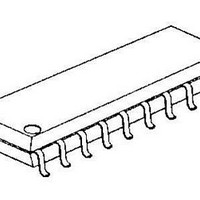NJM3717E2-TE2 NJR, NJM3717E2-TE2 Datasheet - Page 4

NJM3717E2-TE2
Manufacturer Part Number
NJM3717E2-TE2
Description
Motor / Motion / Ignition Controllers & Drivers Stepping Motor Driver
Manufacturer
NJR
Type
Stepper Motor Controller/Driverr
Datasheet
1.NJM3717D2.pdf
(10 pages)
Specifications of NJM3717E2-TE2
Product
Stepper Motor Controllers / Drivers
Operating Supply Voltage
4.75 V to 5.25 V
Supply Current
25 mA
Mounting Style
SMD/SMT
Package / Case
EMP-20
Operating Temperature
- 40 C to + 150 C
Lead Free Status / Rohs Status
Lead free / RoHS Compliant
Current sensor
The current sensor contains a reference voltage divider and three comparators for measuring each of the select-
able current levels. The motor current is sensed as a voltage drop across the current sensing resistor, R
compared with one of the voltage references from the divider. When the two voltages are equal, the comparator
triggers the single-pulse generator. Only one comparator at a time is activated by the input logic.
Single-pulse generator
The pulse generator is a monostable multivibrator triggered on the positive edge of the comparator output. The
multivibrator output is high during the pulse time, t
t
The single pulse switches off the power feed to the motor winding, causing the winding to decrease during t
new trigger signal should occur during t
Output stage
The output stage contains four transistors and four diodes, connected in an H-bridge. The two sinking transistors
are used to switch the power supplied to the motor winding, thus driving a constant current through the winding.
See figures 4 and 5.
Overload protection
The circuit is equipped with a thermal shut-down function, which will limit the junction temperature. The output
current will be reduced if the maximum permissible junction temperature is exceeded. It should be noted, however,
that it is not short circuit protected.
Operation
When a voltage V
i
R = Winding resistance
L = Winding inductance
t =
(see figure 5, arrow 1)
through a low-pass filter, R
above the comparator threshold voltage, the monostable is triggered and its output turns off the conducting sink
transistor.
upper protection diode back through the source transistor (see figure 5, arrow 2).
After the monostable has timed out, the current has decayed and the analog voltage across the sensing resistor is
below the comparator threshold level.
current is turned off via the logic inputs.
turned on after a slight delay. When this happens, the current must first decay to zero before it can reverse. This
current decay is steeper because the motor current is now forced to circulate back through the power supply and
the appropriate sinking transistor protection diode. This causes higher reverse voltage build-up across the winding
which results in a faster current decay (see figure 5, arrow 3).
changed at the same time the current-inhibiting signal is applied (see figure 6).
m
off
The motor current appears across the external sensing resistor, R
The polarity across the motor winding reverses and the current is forced to circulate through the appropriate
The sinking transistor then closes and the motor current starts to increase again, The cycle is repeated until the
By reversing the logic level of the phase input (pin 8), both active transistors are turned off and the opposite pair
For best speed performance of the stepper motor at half-step mode operation, the phase logic level should be
= (V
= 0.69 • R
time
MM
/ R) • (1 - e
T
• C
T
MM
is applied across the motor winding, the current rise follows the equation:
-(R • t ) / L
C
C
)
C
, to the voltage comparator input (pin 10). At the moment the sensed voltage rises
off
, it is ignored.
off
, which is determined by the timing components R
S
, as an analog voltage. This voltage is fed
NJM3717
T
and C
S
, and
off
.If a
T
.




















